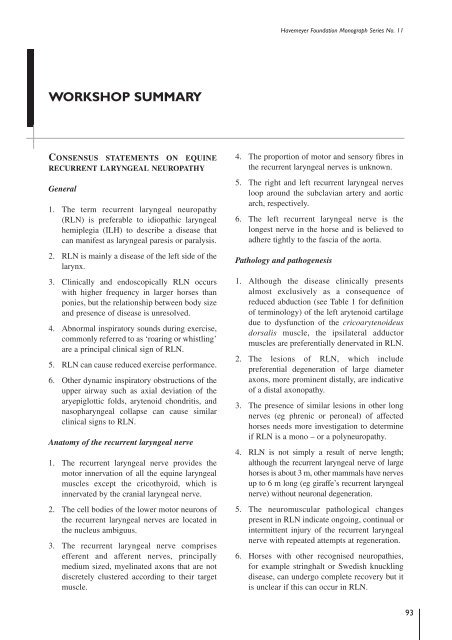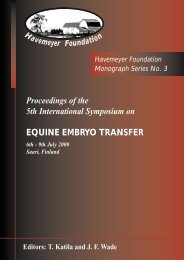Proceedings of a Workshop on - The Havemeyer Foundation
Proceedings of a Workshop on - The Havemeyer Foundation
Proceedings of a Workshop on - The Havemeyer Foundation
You also want an ePaper? Increase the reach of your titles
YUMPU automatically turns print PDFs into web optimized ePapers that Google loves.
<strong>Havemeyer</strong> Foundati<strong>on</strong> M<strong>on</strong>ograph Series No. 11<br />
WORKSHOP SUMMARY<br />
CONSENSUS STATEMENTS ON EQUINE<br />
RECURRENT LARYNGEAL NEUROPATHY<br />
General<br />
1. <strong>The</strong> term recurrent laryngeal neuropathy<br />
(RLN) is preferable to idiopathic laryngeal<br />
hemiplegia (ILH) to describe a disease that<br />
can manifest as laryngeal paresis or paralysis.<br />
2. RLN is mainly a disease <str<strong>on</strong>g>of</str<strong>on</strong>g> the left side <str<strong>on</strong>g>of</str<strong>on</strong>g> the<br />
larynx.<br />
3. Clinically and endoscopically RLN occurs<br />
with higher frequency in larger horses than<br />
p<strong>on</strong>ies, but the relati<strong>on</strong>ship between body size<br />
and presence <str<strong>on</strong>g>of</str<strong>on</strong>g> disease is unresolved.<br />
4. Abnormal inspiratory sounds during exercise,<br />
comm<strong>on</strong>ly referred to as ‘roaring or whistling’<br />
are a principal clinical sign <str<strong>on</strong>g>of</str<strong>on</strong>g> RLN.<br />
5. RLN can cause reduced exercise performance.<br />
6. Other dynamic inspiratory obstructi<strong>on</strong>s <str<strong>on</strong>g>of</str<strong>on</strong>g> the<br />
upper airway such as axial deviati<strong>on</strong> <str<strong>on</strong>g>of</str<strong>on</strong>g> the<br />
aryepiglottic folds, arytenoid ch<strong>on</strong>dritis, and<br />
nasopharyngeal collapse can cause similar<br />
clinical signs to RLN.<br />
Anatomy <str<strong>on</strong>g>of</str<strong>on</strong>g> the recurrent laryngeal nerve<br />
1. <strong>The</strong> recurrent laryngeal nerve provides the<br />
motor innervati<strong>on</strong> <str<strong>on</strong>g>of</str<strong>on</strong>g> all the equine laryngeal<br />
muscles except the cricothyroid, which is<br />
innervated by the cranial laryngeal nerve.<br />
2. <strong>The</strong> cell bodies <str<strong>on</strong>g>of</str<strong>on</strong>g> the lower motor neur<strong>on</strong>s <str<strong>on</strong>g>of</str<strong>on</strong>g><br />
the recurrent laryngeal nerves are located in<br />
the nucleus ambiguus.<br />
3. <strong>The</strong> recurrent laryngeal nerve comprises<br />
efferent and afferent nerves, principally<br />
medium sized, myelinated ax<strong>on</strong>s that are not<br />
discretely clustered according to their target<br />
muscle.<br />
4. <strong>The</strong> proporti<strong>on</strong> <str<strong>on</strong>g>of</str<strong>on</strong>g> motor and sensory fibres in<br />
the recurrent laryngeal nerves is unknown.<br />
5. <strong>The</strong> right and left recurrent laryngeal nerves<br />
loop around the subclavian artery and aortic<br />
arch, respectively.<br />
6. <strong>The</strong> left recurrent laryngeal nerve is the<br />
l<strong>on</strong>gest nerve in the horse and is believed to<br />
adhere tightly to the fascia <str<strong>on</strong>g>of</str<strong>on</strong>g> the aorta.<br />
Pathology and pathogenesis<br />
1. Although the disease clinically presents<br />
almost exclusively as a c<strong>on</strong>sequence <str<strong>on</strong>g>of</str<strong>on</strong>g><br />
reduced abducti<strong>on</strong> (see Table 1 for definiti<strong>on</strong><br />
<str<strong>on</strong>g>of</str<strong>on</strong>g> terminology) <str<strong>on</strong>g>of</str<strong>on</strong>g> the left arytenoid cartilage<br />
due to dysfuncti<strong>on</strong> <str<strong>on</strong>g>of</str<strong>on</strong>g> the cricoarytenoideus<br />
dorsalis muscle, the ipsilateral adductor<br />
muscles are preferentially denervated in RLN.<br />
2. <strong>The</strong> lesi<strong>on</strong>s <str<strong>on</strong>g>of</str<strong>on</strong>g> RLN, which include<br />
preferential degenerati<strong>on</strong> <str<strong>on</strong>g>of</str<strong>on</strong>g> large diameter<br />
ax<strong>on</strong>s, more prominent distally, are indicative<br />
<str<strong>on</strong>g>of</str<strong>on</strong>g> a distal ax<strong>on</strong>opathy.<br />
3. <strong>The</strong> presence <str<strong>on</strong>g>of</str<strong>on</strong>g> similar lesi<strong>on</strong>s in other l<strong>on</strong>g<br />
nerves (eg phrenic or per<strong>on</strong>eal) <str<strong>on</strong>g>of</str<strong>on</strong>g> affected<br />
horses needs more investigati<strong>on</strong> to determine<br />
if RLN is a m<strong>on</strong>o – or a polyneuropathy.<br />
4. RLN is not simply a result <str<strong>on</strong>g>of</str<strong>on</strong>g> nerve length;<br />
although the recurrent laryngeal nerve <str<strong>on</strong>g>of</str<strong>on</strong>g> large<br />
horses is about 3 m, other mammals have nerves<br />
up to 6 m l<strong>on</strong>g (eg giraffe’s recurrent laryngeal<br />
nerve) without neur<strong>on</strong>al degenerati<strong>on</strong>.<br />
5. <strong>The</strong> neuromuscular pathological changes<br />
present in RLN indicate <strong>on</strong>going, c<strong>on</strong>tinual or<br />
intermittent injury <str<strong>on</strong>g>of</str<strong>on</strong>g> the recurrent laryngeal<br />
nerve with repeated attempts at regenerati<strong>on</strong>.<br />
6. Horses with other recognised neuropathies,<br />
for example stringhalt or Swedish knuckling<br />
disease, can undergo complete recovery but it<br />
is unclear if this can occur in RLN.<br />
93








